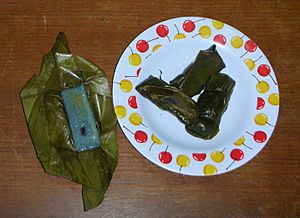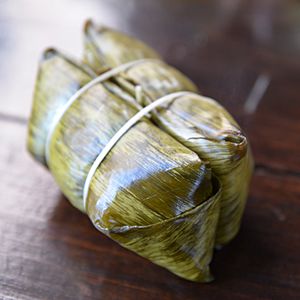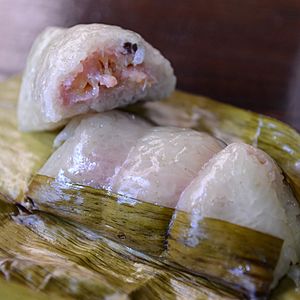Khao tom facts for kids

Khao tom can be either savory or sweet. This one from Laos, with a pork fat and mung bean filling, is savory.
|
|
| Alternative names | Khao tom mat Khao tom phat |
|---|---|
| Course | Dessert |
| Place of origin | Mainland Southeast Asia |
| Region or state | Southeast Asia |
| Associated national cuisine | Thailand and Laos |
| Main ingredients | Sticky rice, banana leaves, coconut milk |
| Variations | Khao tom mat sai kluai, Khao tom mat sai mu, Khao tom mat sai phueak |

Have you ever heard of a delicious dessert wrapped in a banana leaf? That's Khao tom (pronounced kao tom)! It's a popular sweet treat from Southeast Asia, especially in Thailand and Laos.
Khao tom is made from special sticky rice. This rice is seasoned and then steamed inside a banana leaf wrapper. It's a bit like other yummy wrapped foods you might find in Asia, such as suman from the Philippines or bánh tét from Vietnam. Sometimes, Khao tom is also called Khao tom mat.
Contents
Different Kinds of Khao Tom
Khao tom can be either sweet or savory.
- Sweet Khao Tom: This version is often filled with yummy coconut milk and sweet banana.
- Savory Khao Tom: This one might have fillings like pork fat and mung beans.
In Thailand, you might even see Khao tom that is colored blue! This special color comes from Clitoria ternatea flowers. The most common ingredients for Khao tom mat are black beans and banana.
The name of Khao tom mat often changes based on what's inside:
- Khao tom mat sai pheuak means it's filled with Taro.
- Khao tom mat sai kluai means it has Banana inside.
- Khao tom mat sai mu means it's made with Pork.
Special Traditions with Khao Tom
Khao tom is more than just a dessert; it's part of many special traditions!
The Sai Krachat Tradition
In Lopburi Province in Thailand, there's a tradition called Sai Krachat. This is a Buddhist event where people make merit, which means doing good deeds. It happens the day before a big celebration called the Great Birth Sermon. People prepare khao tom and other foods like rice noodles.
On Sai Krachat Day, people visit friends and family. They bring gifts like bananas, sugar cane, oranges, candles, and incense sticks. They put these gifts into bamboo baskets at the host's house. In return, the hosts welcome their guests with prepared food. When visitors leave, the hosts give them khao tom mat as a souvenir. This gift is called Khuen Krachat.
Khao Tom and Love
In Thailand, khao tom mat is a symbol of couples and love. This is because the two pieces of khao tom mat are often tied together with a thin bamboo strip, just like a couple is bound together.
Thai people believe that if a couple offers khao tom mat to monks on Khao Phansa Day, their married life will be smooth and their love will be strong and stable. Khao Phansa Day marks the start of the three-month Buddhist lent, a time when monks stay in a monastery to focus on Buddhist teachings.
Khao Tom Luk Yon
Khao tom mat is also a traditional Thai dessert for Wan Ok Phansa Day, which is the end of Buddhist lent in late October. On this day, it's called Khao tom luk yon. It's wrapped in a young mangrove fan palm leaf with long tails. People hold these tails before tossing the khao tom towards a Buddha image. Then, monks can collect them.
In 2014, the Thai Department of Cultural Promotion recognized Khao tom mat as an important part of their cultural heritage. This helps make sure that this special dessert and its traditions are not forgotten.



